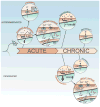Molecular Mechanisms of Sympathetic Remodeling and Arrhythmias
- PMID: 26810594
- PMCID: PMC4730917
- DOI: 10.1161/CIRCEP.115.001359
Molecular Mechanisms of Sympathetic Remodeling and Arrhythmias
Keywords: electrophysiology; myocardial infarction; norepinephrine; receptors, adrenergic; sympathetic nervous system.
Conflict of interest statement
Figures


References
-
- Effect of carvedilol on outcome after myocardial infarction in patients with left-ventricular dysfunction: the CAPRICORN randomised trial. Lancet. 2001;357:1385–1390. - PubMed
-
- Poole-Wilson PA, Swedberg K, Cleland JG, Di Lenarda A, Hanrath P, Komajda M, Lubsen J, Lutiger B, Metra M, Remme WJ, Torp-Pedersen C, Scherhag A, Skene A. Comparison of carvedilol and metoprolol on clinical outcomes in patients with chronic heart failure in the Carvedilol Or Metoprolol European Trial (COMET): randomised controlled trial. Lancet. 2003;362:7–13. - PubMed
-
- Effect of metoprolol CR/XL in chronic heart failure: Metoprolol CR/XL Randomised Intervention Trial in-Congestive Heart Failure (MERIT-HF) Lancet. 1999;353:2001–2007. - PubMed
-
- Schwartz PJ. Cardiac sympathetic denervation to prevent life-threatening arrhythmias. Nat Rev Cardiol. 2014;11:346–353. - PubMed
Publication types
MeSH terms
Substances
Grants and funding
LinkOut - more resources
Full Text Sources
Other Literature Sources
Medical

